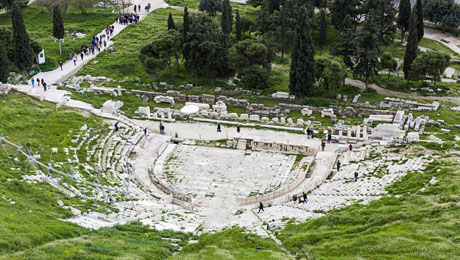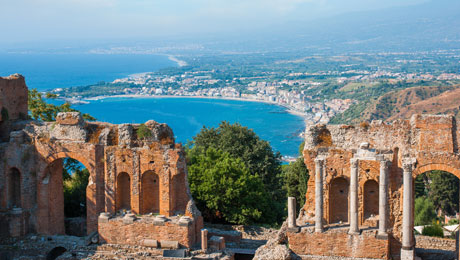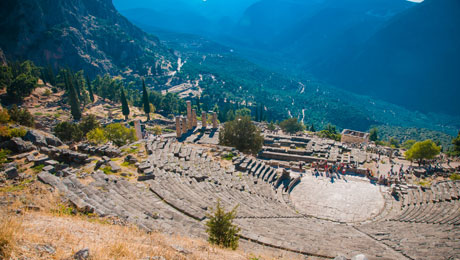Irodio, pictures: www.clickatlife.gr
In ancient Athens, theatre was considered the most important art. Performances combined poetry, dance and theatre. Theatre had a markedly religious and mystical nature at the beginning, but also a social and political nature during the period of its development. Today, theatre is a force of creativity and inspiration everywhere. Most people have probably heard of Broadway in New York, the Bolshoi Theatre in Moscow, La Scala in Milan and Sydney Opera House.
However, there are theatres of the past, some of which remain in very good condition and still host performances.
The Odeon of Herod Atticus in Athens
Located on the south side of the Acropolis, the theatre, also known as Irodio, was built in 161 BC by Herod Atticus in memory of his wife. It was designed primarily for music performances and was therefore called Odeon (“odeio” in Greek).
Seats for the audience were deployed in 32 rows of marble benches, to accommodate a total of 5,000 viewers. Like theatres from the Roman era, the orchestra had a semi-circular shape. Performance buildings were located behind the stage and were located on 3 floors, two of which are still preserved today, with a height of 28 metres. The Odeon had a cedar wood floor.
Its most important partial restoration began after World War II in the 1950s, when the whole building and its purpose was revealed. The seats are covered with Pendeli marble and the orchestra – with marble slabs from Hymettos. Since the end of this decade, the Irodio has mainly been used for cultural events in the summer.
The ancient theatre of Epidaurus

The theatre at Epidaurus is without doubt the most famous and best preserved ancient theatre in the world. It functioned as the religious and political centre of Epidaurus, a city-state, which existed in the shadow of more powerful cities such as Corinth, Sparta and Athens. Excavations began in 1880 and ended in the 20th century. They revealed the most perfect model of an ancient Greek theatre.
It has 55 rows of seats, divided in 12 benches at the bottom and 20 at the top, for more than 20,000 viewers. The legendary acoustics of the theatre have been examined by experts for years. According to some theories, surrounding winds contribute to the acoustics, while others claim that the secret is in the plan of seats. However, no theory is absolute, even after decades of research.
The Roman theatre in Orange, France
Built by Emperor Augustus in the 1st century, it was closed by an official order in 391 because of the opposition of the Christian Church. Afterwards, the theatre was completely abandoned, plundered by the Barbarians and used as a defensive post in the Middle Ages. During the religious wars of the 16th century, it was an asylum for the city's inhabitants. It was restored in the 19th century and today hosts the summer opera festival Chorégies d'Orange.
The Ancient theatre of Dionysus, Athens

Located in the shadow of the Acropolis, it is believed to be the oldest theatre in the world. In classical times, various performances were given here during the Dionysian festivals, one of the most important religious festivals of the city. It is assumed that it was built by descendants of tyrant Pisistratus and it has undergone many changes and extensions. What has been preserved until today is from the late Roman period, with several rows of seats from the classical era. Attempts are being made for the restoration of the ancient theatre using the original stones from Corinth, which are scattered throughout the area.
The theatre in Merida, Spain
Merida has many important buildings, but its theatre is undoubtedly the most important one not only in the city, but perhaps on the entire Iberian Peninsula. It is an excellent example of a classic Roman theatre. It has three horizontal areas of seats corresponding to the social status of spectators. It is assumed to have accommodated about 5,500 viewers. It was restored in 1970. Even today, the annual festival of classical theatre is held there.
The Greek Theatre in Taormina, Sicily

Taormina was a Greek colony on the east coast of Sicily. The theatre was built in the 2nd century BC and offers stunning views over beautiful places in the region - Etna and the sea. The theatre was renewed and extended by the Romans and today it is one of the largest ancient theatres in Sicily, second only to that of Syracuse. Taormina Arte, the International Film Festival and Dance Festival are organised here.
The Roman Theatre in Amman, Jordan
This is probably the most impressive monument in Jordan, built during the reign of Antoninus Pius. It accommodated 6,000 visitors. It consists of three parts, and its restoration began in 1957. There was a colonnade in Corinthian style in front of it and an ancient street, covered with stones, a part of which has been recovered.
The theatre of Delphi
